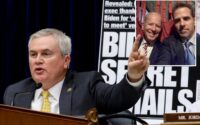Biden backed teacher union head Randi Weingarten over honoring promise to get kids back in school during COVID: book
President Biden told teacher union honcho Randi Weingarten just eight days into his term that “I am not abandoning you” — opting to keep a major ally and donor onside over honoring his campaign promise to get COVID pandemic-affected kids back in school by his 100th day in office, a bombshell new book has revealed.
The Jan. 28, 2021, call from Biden to the American Federation of Teachers president at her New York home — recounted by Franklin Foer in his new book “The Last Politician” — came one day before Weingarten and her lieutenants launched a drive to weaken reopening guidance issued two weeks later by the Centers for Disease Control and Prevention.
Biden, Foer writes, told Weingarten that “he knew she was taking a lot of heat around the reopening of schools” and reassured her that “he was an abiding friend.”
“I am not abandoning you on schools,” Biden reportedly said. “I want you to know that.”
The pressure by Weingarten, which The Post first revealed in May 2021 and further detailed earlier this year, also followed a Jan. 21 meeting at the White House with her, first lady Jill Biden, and National Education Association President Becky Pringle. During that meeting, Foer recounts, the first lady — herself a NEA member — hailed Weingarten as the “type of general who is never far from the front lines.”

“I said I was going to bring you with me into the White House,” Jill Biden told Weingarten and Pringle, according to Foer. “And on day one, you’re here.”
Beginning Jan. 29, 2021, then-CDC Director Rochelle Walensky emailed, called and texted Weingarten to discuss the much-anticipated guidelines, a level of collaboration which did not go unnoticed by the union.
“Thank you again for Friday’s rich discussion about forthcoming CDC guidance and for your openness to the suggestions made by our president, Randi Weingarten, and the AFT,” emailed Kelly Trautner, AFT’s senior director for health issues on Monday, Feb. 1, describing the union as the CDC’s “thought partner.” The message was forwarded to Walensky by Carole Johnson, the White House coronavirus testing coordinator.

Other exchanges revealed Weingarten suggested language that halted a full return to schools, prolonging learning disruptions that have led to a sharp decline in math and reading scores across America.
On Feb. 11, the day before the guidance was released, the AFT president texted Walensky directly to say she had “heard something from a [New York Times] leak that seemed at odds with discussion. Do you have time for a call.”
Walensky lamented in response that she was in a “wall of meetings” and asked Weingarten to “ping what you learned.”

The language to which Weingarten objected read, in part, “all schools can provide in-person instruction (either full or hybrid), through strict adherence to mitigation strategies.”
In the guidance released the following day, the phrase “all schools can provide in-person instruction” was changed to to “all schools have options to provide in-person instruction.”
The guidelines also included two “suggestions” AFT made to the CDC, allowing for both school closures based on high levels of community transmission and remote work options for teachers deemed to either have a higher risk of contracting COVID-19 themselves or be living with someone of a similar risk profile.

The AFT praised the guidance in a press release, saying “the CDC met fear of the pandemic with facts and evidence,” though the agency had published a study the month before that showed in-person instruction had not “contributed meaningfully to increased community transmission” of the virus.
Meanwhile, the White House revised the initial pledge by Biden, from reopening “the majority of our schools” by the 100-day mark (April 30, 2021), to applying it only to schools up to 8th grade, to considering them open if they only offered in-person instruction once per week.
“His goal that he set is to have the majority of schools — so, more than 50[%] — open by day 100 of his presidency. And that means some teaching in classrooms. So, at least one day a week. Hopefully, it’s more. And obviously, it is as much as is safe in each school and local district,” then-White House press secretary Jen Psaki told reporters Feb. 9.

By that time, about two-thirds of America’s schools were already offering at least one day of in-person learning each week, what many parents considered the bare minimum.
Psaki’s announcement, Foer writes, amounted to Biden “conceding that for thousands of students the rest of the [2020-21] school year would be lost to the pandemic,” the result of a strategy to “ease the unions into accepting his goals, avoiding that sort of confrontation that might explode in a strike.”
Biden, according to Foer, “was never going to force teachers to return to school. His plan was to give them time and space to get comfortable with the idea, to smother them in the love of Jill Biden.”

The ongoing closures, in the White House’s view, was “the price of peace.”
In September 2020, however, Biden had blamed then-President Donald Trump and his education secretary for failing to get students back into classrooms.
“Donald Trump and Betsy DeVos haven’t stepped up. And we’re all seeing the result,” he said during a speech in Wilmington, Del. “Millions of students are now starting a new school year the same way they finished the last one — at home.”

On Feb. 14, 2021, Walensky declined to say in a CNN interview whether her agency’s guidelines were supported by science and advocated for remote learning options in roughly 99% of public school districts labeled as high-spread zones.
The Biden administration would not announce until early 2022 that 95% of US public schools had returned to full-time, in-person learning.
AFT gave more than $2.6 million to Democratic candidates during the 2020 election cycle, according to the political donation tracking website OpenSecrets, while the NEA gave more than $2.4 million. Biden himself received more than $245,000 from teacher’s unions during the campaign, more than four times the amount taken in by the next-closest candidate — Sen. Bernie Sanders (I-Vt.)

Biden’s long and profitable relationship with Weingarten dated back to at least 2010, when the two came face-to-face during a labor meeting after a Rhode Island school board had fired all of its faculty for having delivered “appalling test results” that year, Foer wrote.
Then-President Barack Obama had praised the school board decision, but Biden privately expressed disagreement with his boss to Weingarten after she browbeat him during the meeting.
“I hear you. Give me time, and I’ll work this out,” Biden whispered to her, according to Foer, who wrote that Biden’s anger and defensiveness at her attacks on Obama “was dutiful and performative. Despite Biden’s loyalty to his boss, Weingarten felt as if she had discovered a genuine ally.”
Reps for the AFT and NEA did not immediately respond to a request for comment.


